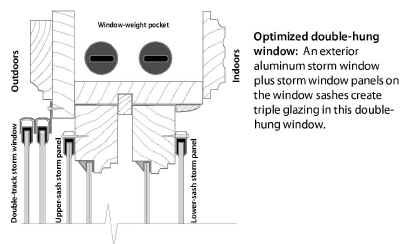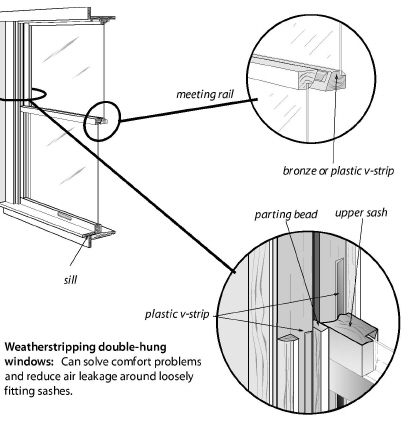
7.2 Window Repair and Air Leakage Reduction
With the exception of broken glass or missing window panes, windows aren’t often the major source of air leakage in an existing home.
Window weatherstripping may solve comfort problems around windows, even though it may not be cost-effective. Avoid expensive or time-consuming window repair measures that are implemented to solve minor comfort complaints if the weatherization budget is limited.
7.2.1 Double-Hung Window Weatherization
|
SWS Details: 3.1202.1 Fixed Frame with Wood Sash—Older House, 3.1201.2 Single-Unit Window and Fixed Frame with Wood Sash, 3.1201.1 Double-Hung Wood Windows |
Re-glazing window sashes in a quality manner is time consuming. This task is best accomplished as part of a comprehensive window rehabilitation project. Re-glazing wood windows may not be a durable repair without thorough scraping, priming, and painting. Use lead-safe work practices when working on windows. See page 52.
Repair measures may include the following.
ü Replace missing or broken glass. Use glazing compound and glazier points when replacing glass in old windows.
ü Caulk the window frame where appropriate to prevent air leakage, condensation, and rain leakage. Use sealants with adhesion and joint-movement characteristics appropriate for both the window frame and the building materials surrounding the window.
ü Replace missing or severely deteriorated window frame components.
ü Fill damaged wood with epoxy, before priming and painting.
ü Adjust window stops if gaps exist between the stop and jamb. Ensure that the window operates smoothly following adjustment.
ü Weatherstrip large gaps between the sash and the sill or stops. Weatherstrip the meeting rails if needed.
ü Replace or repair missing or non-functional top and side sash locks, hinges, or other hardware if this significantly reduces air leakage.

7.2.2 Weatherstripping Double-Hung Windows
Window weatherstripping is mainly a comfort retrofit and not a high weatherization priority.
Paint is the primary obstacle when weatherstripping double-hung windows. Often the upper sash has slipped down, and is locked in place by layers of paint, producing a leaking gap between the meeting rails of the upper and lower sashes.
ü To make the meeting rails meet again, either break the paint seal and push the upper sash up, or cut the bottom of the lower sash off to bring it down.

ü To lift the upper sash, cut the paint around its inside and outside perimeter. Use leverage or a small hydraulic jack to lift the sash. Jack only at the corners of the sash. Lifting in the middle can break the glass.
ü Block, screw, or nail the repositioned upper sash into place.
ü To weatherstrip the window, remove the lower sash. Cut the paint where the window stop meets the jamb so the paint doesn’t pop off in large flakes as you pry the stop off. Removing one stop is sufficient to remove the bottom sash.
ü Scrape excess paint from the sashes and the window sill.
ü Apply vinyl V-strip to the side jambs, and bronze V-strip to the meeting rail on the top sash. The point of the bronze V goes skyward. The weatherstrip is caulked on its back side and stapled in place, as shown in the illustration.
